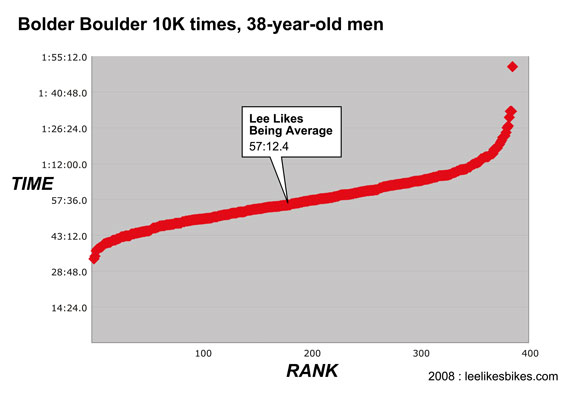Perfectly average: Running the Bolder Boulder 10K

In a stunning shift of priorities, I skipped the Angel Fire MSC this year and instead ran the Bolder Boulder 10k. So today, rather than pinning it through aspen forests by myself, I jogged through city streets with 50,000 goofballs. I am proud to say I finished right in the middle.
Lee Hates Running dot com
Running and me, we are not long-time friends. Running seems like such a fundamental human skill, but it has eluded me for most of my life.
Back in the day, I was the overweight asthmatic kid who got picked last and got a doctor’s excuse from the mile run. I tried SO hard to pass the Presidential Physical Fitness test, but that dang 600-yard run … I just couldn’t do it. I was in military school back then, and that run cost me a sweet medal for my dress uniform.
As a young adult, I compensated with a few years of triathlon and 6% body fat (still … feel … fat). I put in a mediocre swim leg, pinned the bike at pro pace, then tried to survive the run. I would literally get passed by old ladies. I sucked on my feet.
When Super Ds switched from time trials to LeMans starts, I went from killing it to getting killed — I was last on the bike every time, then I had to fight for every position. I recently put in some study time, cleaned up my mechanics and have become a semi-decent runner. I can sprint well enough to start a Super D in a good position, and I jog about 30 minutes most weeks. It doesn’t always suck.
My last 10K was in a triathlon around 1990. Going into today’s adventure, I hoped to stay comfortable and be able to enjoy the experience.
Running Action Magazine
 |
Cool! Rad! Sick!
Best t-shirt seen on course: “People ask me why I run track. I ask them, what do you do when someone fires a gun?”
Best side-line band: Some hard-looking dudes rocking out a Talking Heads cover.
Best way to get muddy and bloody: The Slip ‘N’ Slide that dropped off someone’s porch, down the grass slope, through sloppy muck and onto the sidewalk.
Best moment: Ripping down Pearl Street in a huge crowd. Music, people, color and motion everywhere. A sense of being swept along some archetypical river.
Family fun: I started the race with my kids Kate and Ian and their friend Preston. Ian and Preston have been running a lot in basketball practice; Kate has been rocking the Wii Fitness game. The Wife drove shuttle (thanks!).
Tortoise and the hares: The boys and I jogged together for a while, then they sprinted for the Mile 2 line. Kaboom! They exploded, and I kept chugging along. At Mile 3, Preston told Ian he was going to catch and beat me — and he did, by 22 seconds. Ian, more of a sprinter, came in strong at 1:06. Kate pulled off course and went back to bed.
Perfectly average: I stayed comfortable, kept a consistent pace and enjoyed the scene. It was pretty amazing to look ahead and see a sea of bobbing bodies, and to realize that I was bobbing in that same sea. Compared with downhill racing, it’s a totally different kind of awareness; just relax, find your flow and let it happen (wait, maybe it’s the same as DH).
I ran a 57:12 with an average pace of 9:13 per mile. That put me 200th out of 386 38-year-old men. Perfectly average.
And perfectly satisfying (for now.)

Comments are closed.